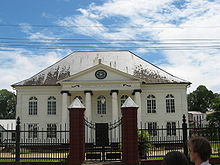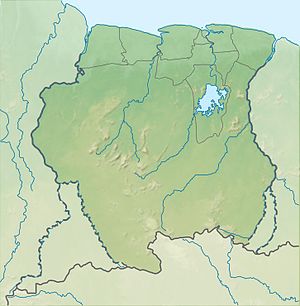Paramaribo
Paramaribo | |
|---|---|
 The street Waterkant in Paramaribo | |
| Nickname: Par'bo | |
Location in Suriname and South America | |
| Coordinates: 5°51′8″N 55°12′14″W / 5.85222°N 55.20389°W | |
| Country | |
| District | Paramaribo District |
| Founded | 1603 |
| Area | |
| • Total | 182 km2 (70 sq mi) |
| Elevation | 3 m (10 ft) |
| Population (2012 census) | |
| • Total | 240,924 |
| • Density | 1,300/km2 (3,400/sq mi) |
| Time zone | UTC-3 (ART) |
Paramaribo (Dutch pronunciation: [ˌpaːraːˈmaːriboː], nickname: Par′bo) is the capital and largest city of Suriname, located on the banks of the Suriname River in the Paramaribo District. Paramaribo has a population of roughly 241,000 people (2012 census), almost half of Suriname's population. The historic inner city of Paramaribo has been a UNESCO World Heritage Site since 2002.
Name
The city is named for the Paramaribo tribe living at the mouth of the Suriname River; the name is from Tupi–Guarani para "large river" + maribo "inhabitants".[1]
History

The name Paramaribo is probably a corruption of the name of an Indian village, Parmirbo. This was the location of the first Dutch settlement, a trading post established by Nicolaes Baliestel and Dirck Claeszoon van Sanen in 1613. English and French traders also tried to establish settlements in Suriname, including a French post established in 1644 near present-day Paramaribo.
The Dutch settlement was abandoned some time before the arrival of English settlers in 1650. The settlers were sent by the English governor of Barbados, Lord Francis Willoughby, 5th Baron Willoughby of Parham, and established a town on the site of Paramaribo (though probably south of the current town center). The town was protected by a fort, called Fort Willoughby. In 1662, Governor Willoughby was granted the settlement and surrounding lands (extending into Suriname’s interior) by King Charles II.
In 1667, during the Second Anglo-Dutch War, Paramaribo was conquered by a squadron of ships under Abraham Crijnssen. The Treaty of Breda in 1667, confirmed Paramaribo as the leading town of the now Dutch colony of Suriname. The fort protecting Paramaribo was renamed Fort Zeelandia in honor of the Dutch province that had financed Crijnssen’s fleet. (The town was also renamed New Middelburg but the name did not catch on with the inhabitants).
The population of Paramaribo has always been very diverse. Among the first British settlers were many Jews [2] and one of the oldest synagogues in the Americas is found in Paramaribo.[3] The population of the town was greatly increased after 1873, when former slaves (who had been freed in 1863) were allowed to stop working for their former masters and leave the sugar plantations.
Paramaribo has remained the capital of Suriname, from its colonial days through the independence of Suriname in 1975 to the present day. The old town has suffered many devastating fires over the years, notably in January 1821 (which destroyed over 400 buildings) and September 1832 (which destroyed nearly 50 buildings).
In 1987 an administrative reorganization took place in Suriname and the city was divided into 12 administrative jurisdictions.
Geography

The city is located on the Suriname River, approximately 15 kilometres (9.3 mi) inland from the Atlantic Ocean, in the Paramaribo district.
- Evolution of Paramaribo
-
Paramaribo around 1737.
-
Paramaribo in 1821. Indicated in brown is the area devastated by the city fire of that year.
-
Paramaribo around 1876.
-
Paramaribo around 1916-1917
Climate
Paramaribo features a tropical rainforest climate, under the Köppen climate classification. The city has no true dry season, all 12 months of the year average more than 60 mm of rainfall, but the city does experience noticeably wetter and drier periods during the year. "Autumn" (September through November) is the driest period of the year in Paramaribo. Common to many cities with this climate, temperatures are relatively consistent throughout the course of the year, with average high temperatures of 31 degrees Celsius and average low temperatures of 22 degrees Celsius. Paramaribo on average receives roughly 2200 mm of rainfall each year.
| Climate data for Paramaribo | |||||||||||||
|---|---|---|---|---|---|---|---|---|---|---|---|---|---|
| Month | Jan | Feb | Mar | Apr | May | Jun | Jul | Aug | Sep | Oct | Nov | Dec | Year |
| Record high °C (°F) | 33 (91) |
34 (93) |
35 (95) |
37 (99) |
37 (99) |
36 (97) |
37 (99) |
37 (99) |
36 (97) |
37 (99) |
36 (97) |
36 (97) |
37 (99) |
| Mean daily maximum °C (°F) | 30 (86) |
30 (86) |
30 (86) |
31 (88) |
30 (86) |
31 (88) |
31 (88) |
32 (90) |
33 (91) |
33 (91) |
32 (90) |
30 (86) |
31 (88) |
| Daily mean °C (°F) | 26 (79) |
26 (79) |
26 (79) |
27 (81) |
27 (81) |
27 (81) |
27 (81) |
27 (81) |
28 (82) |
28 (82) |
27 (81) |
26 (79) |
27 (81) |
| Mean daily minimum °C (°F) | 22 (72) |
22 (72) |
22 (72) |
22 (72) |
23 (73) |
22 (72) |
22 (72) |
23 (73) |
23 (73) |
23 (73) |
23 (73) |
22 (72) |
22 (72) |
| Record low °C (°F) | 17 (63) |
17 (63) |
17 (63) |
18 (64) |
19 (66) |
20 (68) |
20 (68) |
15 (59) |
21 (70) |
20 (68) |
21 (70) |
18 (64) |
15 (59) |
| Average precipitation mm (inches) | 200 (7.9) |
140 (5.5) |
150 (5.9) |
210 (8.3) |
290 (11.4) |
290 (11.4) |
230 (9.1) |
170 (6.7) |
90 (3.5) |
90 (3.5) |
120 (4.7) |
180 (7.1) |
2,220 (87.4) |
| Source: Weatherbase[4] | |||||||||||||
Demographics
| Year | Pop. | ±% p.a. |
|---|---|---|
| 1790 | 18,000 | — |
| 1831 | 15,265 | −0.40% |
| 1853 | 16,031 | +0.22% |
| 1980 | 167,798 | +1.87% |
| 1995 | 228,551 | +2.08% |
| 2004 | 242,946 | +0.68% |
| 2012 | 240,924 | −0.10% |
| UNESCO World Heritage Site | |
|---|---|
 Colonial style houses, Waterkant, Paramaribo | |
| Criteria | Cultural: ii, iv |
| Reference | 940 |
| Inscription | 2002 (26th Session) |
| Area | 30 ha |
| Buffer zone | 60 ha |
Paramaribo has a population of 240,924 people (2012 census). While the population number is stagnating in recent years, many towns in the surrounding Wanica District are increasing in population.
The city is famed for its diverse ethnic makeup, including Creoles (African or mixed African-European descent) 27%, Indian (East Indian descent) 23%, Multiracials 18%, Maroons (descendants of escaped African slaves) 16%, Javanese (Indonesian descent) 10%, Indigenous (descendants of native population) 2%, Chinese (descendants of 19th-century contract workers) 1.5%, and smaller numbers of Europeans (primarily of Dutch and Portuguese descent), Lebanese and Jews. In the past decades a significant number of Brazilians, Guyanese and new Chinese immigrants have settled in Paramaribo.
Economy
Paramaribo is the business and financial centre of Suriname. Even though the capital city does not produce significant goods itself, almost all revenues from the country's main export products gold, oil, bauxite, rice, and tropical wood are channeled through its institutions. All banks, insurance corporations and other financial and commercial companies are headquartered in Paramaribo. Around 75 percent of Suriname's GDP is consumed in Paramaribo.
Tourism is an increasingly important sector, with most visitors coming from the Netherlands.[5]
Government

Administratively, Paramaribo forms its own district in Suriname. The resorts of Paramaribo district therefore correspond to boroughs of the city. There are twelve resorts in the Paramaribo district:
| Resort | Area in square km | Population density | Population (2012) |
|---|---|---|---|
| Blauwgrond | 43 | 661.3 | 31,483 |
| Rainville | 31 | 930.7 | 22,747 |
| Munder | 14 | 1146.4 | 17,234 |
| Centrum | 9 | 3252.7 | 20,631 |
| Beekhuizen | 6 | 3297.2 | 17,185 |
| Weg naar Zee | 41 | 321.3 | 16,037 |
| Welgelegen | 7 | 3387.0 | 19,304 |
| Tammenga | 6 | 2385.5 | 15,819 |
| Flora | 4 | 3836.5 | 19,538 |
| Latour | 6 | 4358.0 | 29,526 |
| Pontbuiten | 6 | 3246.2 | 23,211 |
| Livorno | 9 | 931.8 | 8,209 |
Transport
Paramaribo is served by the Johan Adolf Pengel International Airport and Zorg en Hoop Airport for local flights. The Jules Wijdenbosch Bridge, which is part of the East-West Link, connects Paramaribo with Meerzorg on the other side of the Suriname River.
Most airlines like Gum Air, Caricom Airways and Blue Wing Airlines have their head offices on the grounds of Zorg en Hoop Airport in Paramaribo.
Education
Paramaribo's institution of higher learning is Anton de Kom University of Suriname, the country's only university.
Healthcare
Paramaribo is home to four hospitals, the Academic Hospital Paramaribo, 's Lands Hospitaal, Sint Vincentius Hospital and Diakonessenhuis.
Historic inner city of Paramaribo
The Dutch colonial town established in 17th and 18th centuries was declared a UNESCO World Heritage Site in 2002.[6] The historic inner city is located along the left bank of the Suriname River. The original architecture of buildings and street plan has largely remained intact and preserved.
Notable landmarks




- Fort Zeelandia
- Presidential Palace of Suriname
- Roman Catholic St Peter and St Paul Cathedral
- Suriname Mosque
- National Assembly of Suriname
- Neveh Shalom Synagogue
- The Arya Dewaker Hindu Temple
- Garden of Palms, a landscape garden of royal palms behind the presidential palace
Notable people
- Ronny Aloema, goal keeper
- Maarten Atmodikoro, football player
- Regi Blinker, football player
- Remy Bonjasky, kickboxer
- Edson Braafheid, football player
- Romeo Castelen, football player
- Augusta Curiel, photographer[7]
- Edgar Davids, football player
- Henk Fraser, football player
- Ulrich van Gobbel, football player
- Jimmy Floyd Hasselbaink, football player
- Jerry de Jong, football player
- Kelvin Leerdam, football player
- Stanley Menzo, football player
- Herman Rijkaard, football player
- Andy Ristie, kickboxer
- Grace Schneiders-Howard, 1869-1968) civil service worker/politician[8]
- Clarence Seedorf, football player
- Andwélé Slory, football player
- Tyrone Spong, kickboxer and Mixed Martial Artist
- Mark de Vries, football player
- Fabian Wilnis, football player
- Aron Winter, football player
- Pim de la Parra, director
Twin towns – sister cities
Paramaribo is twinned with:
 Antwerp, Belgium.
Antwerp, Belgium. Hangzhou, China.
Hangzhou, China. Georgetown, Guyana
Georgetown, Guyana Willemstad, Curaçao.[9]
Willemstad, Curaçao.[9] Yogyakarta, Indonesia.
Yogyakarta, Indonesia.
See also
References
- ^ E.M. Pospelov, Geograficheskie nazvaniya mira (Moscow: Russkie slovari, 1998), p. 322.
- ^ "Extract of the Dutch Map Representing the Colony of Surinam". World Digital Library. 1777. Retrieved 2013-07-13.
- ^ Fox, Tamar (18 February 2011). "Discovering Suriname's Jewish past - and present". Travel. Washington Post. Retrieved 13 July 2013.
- ^ "Weatherbase: Historical Weather for Paramaribo".
- ^ [1][dead link]
- ^ "UNESCO Listing of Paramaribo Inner City". Retrieved 31 Dec 2017.
{{cite web}}: Cite has empty unknown parameter:|dead-url=(help) - ^ djr (2016-10-11). "Digitaal Vrouwenlexicon van Nederland". resources.huygens.knaw.nl (in Dutch). Retrieved 2016-12-18.
- ^ Hoefte, Rosemarijn (6 March 2017). "Howard, Grace Ruth (1869-1968". Huygens ING (in Dutch). University of Groningen, Groningen, The Netherlands: Digitaal Vrouwenlexicon van Nederland. Archived from the original on 28 October 2017. Retrieved 28 October 2017.
- ^ Willemstad World Heritage City. Curacaomonuments.org. Retrieved on 2012-05-19.
External links
 Paramaribo travel guide from Wikivoyage
Paramaribo travel guide from Wikivoyage






